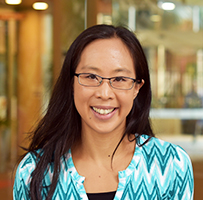Associate Professor Jessica Mar is a group leader working in Stem Cell Ageing and Regenerative Engineering at AIBN. She and her team are developing new bioinformatics methods to understand how regulatory processes go awry in human diseases.
 “What we’re really interested in is understanding heterogeneity: this idea that no two cells are the same — even from the same person — and really focussing on what makes these cells different,” says Mar.
“What we’re really interested in is understanding heterogeneity: this idea that no two cells are the same — even from the same person — and really focussing on what makes these cells different,” says Mar.
“Ageing is a good example,” she explains. “The idea is to follow cells as they age and understand what parts of that cell are becoming more variable, more heterogeneous, and on the other end of the spectrum understanding what parts of those cells are remaining stable.”
In other words, ageing not only affects different cells in different ways, there is a lot of variation within the same cell. Some genes may remain quite stable as a cell ages, while other genes acquire more damage.
By studying this, it’s possible to determine which genes are important for maintaining the health of ageing cells, she says. Moreover, similar comparisons can be done with stem cells and cancer cells.
“That’s been one exciting aspect of my research: learning that variability or heterogeneity is an important determinant in understanding which genes are important for regulating a particular phenotype or type of cell.”
She offers the analogy of cars.
“You’ve got thousands of cars in the UQ car park, and there are various components of those cars that are quite consistent — like brake pads or steering — and those are really important to how the cars work. But other things are quite superfluous, like the speed of the windshield wipers or the exact angle of the windows. If we had no idea how cars work, then one way to figure it out would be to take these measurements on all parts of the car and determine the spread or heterogeneity in these metrics to give us clues into the most critical parts of the car.”
Mar already has a number of impressive achievements to her name, including recently being awarded the Metcalf Prize from the National Stem Cell Foundation of Australia in recognition of her leadership in stem cell research.

What has been her favourite discovery so far?
Mar explains that when she was a post-doc at Harvard, Professor Alan MacKay-Sim (who is currently Australian of the Year) had built up a bank of stem cells collected from patients with schizophrenia and patients with Parkinson’s disease. Mar and her colleagues used these cells to compare sets of biochemical pathways in these diseases and also compare them with healthy controls.
“We found that patients with Parkinson’s disease had more variability in the gene expression of these pathways compared to patients with schizophrenia, those pathways were much more stable from patient to patient. The healthy group were somewhere in between.”
“This was quite exciting because there is this intuitive understanding that the cell is a system and when you break certain things you expect to have a noisier response because things aren’t working as well. The idea that there were certain components that would get more stable in the presence of disease was quite surprising.”
“It suggested that variability and noise is almost like a tuning parameter, where too much was associated with Parkinson’s but too little was associated with Schizophrenia, but a healthy amount was somewhere in the middle.”
This tells us a lot about the importance of cellular robustness, she says.
“Our cells are exposed to so many different things and somehow they find a way to cope. Heterogeneity, confers a sense of robustness, or plasticity, to respond to all these different kinds of insults, but too much heterogeneity affects regulation as much as too little.”
The next big questions for Mar relate to figuring out how this applies to ageing: do cells have increased or decreased levels of variability in gene expression as we get older? There’s a lot of disagreement in the field, she says, with some researchers certain that variability within and between cells increases as we get older, and others saying it’s the opposite: cells become less noisy and more rigid in their signalling.
“I think it’s a bit of both,” says Mar. “It’s probably the distribution of where in the genome it gets more variable and less variable. That has consequences for different pathways and different tissues. There are all these questions that are open for further investigation.”
As for life outside the lab, Mar is a keen runner.
“If I’m not here, or in a plane, that’s usually what I’m doing.”
In the past 9 years she’s focussed on half-marathons, but is figuratively and literally dipping her toe in the water with triathlons. She’s already signed up for next year’s New York City Triathlon.
“There are a lot of parallels between being an academic and being a runner.”
After all, she says, “you can’t really cram for a half-marathon.”
You have to plan, put in the time, meet deadlines and have big goals.
“It’s a commitment to growth.”
Media: communications@aibn.uq.edu.au



